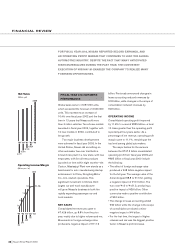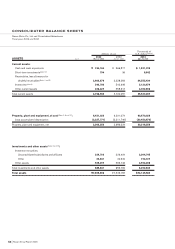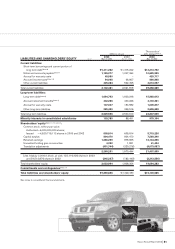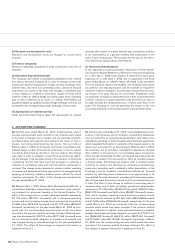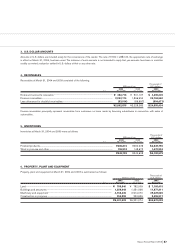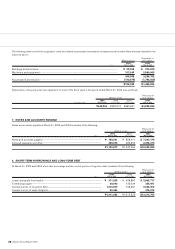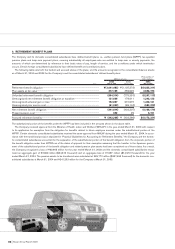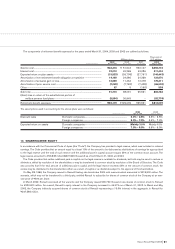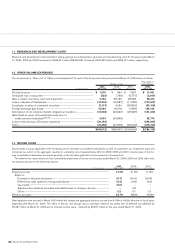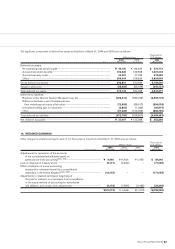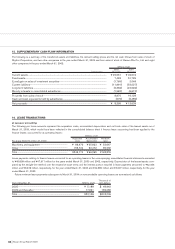Nissan 2004 Annual Report Download - page 57
Download and view the complete annual report
Please find page 57 of the 2004 Nissan annual report below. You can navigate through the pages in the report by either clicking on the pages listed below, or by using the keyword search tool below to find specific information within the annual report.
Nissan Annual Report 2003 55
NOTES TO CONSOLIDATED FINANCIAL STATEMENTS
Nissan Motor Co., Ltd. and Consolidated Subsidiaries
Fiscal year 2003 (Year ended March 31, 2004)
1. SUMMARY OF SIGNIFICANT ACCOUNTING POLICIES
(a) Basis of Presentation
Nissan Motor Co., Ltd. (the “Company”) and its domestic subsidiaries
maintain their books of account in conformity with the financial
accounting standards of Japan, and its foreign subsidiaries maintain
their books of account in conformity with those of their countries of
domicile.
The accompanying consolidated financial statements have been
prepared in accordance with accounting principles generally accepted
in Japan, which are different in certain respects as to the application
and disclosure requirements of International Financial Reporting
Standards, and have been compiled from the consolidated financial
statements prepared by the Company as required by the Securities
and Exchange Law of Japan.
Certain amounts in the prior years’ financial statements have been
reclassified to conform to the current year’s presentation.
(b) Principles of consolidation and accounting for investments
in unconsolidated subsidiaries and affiliates
The accompanying consolidated financial statements include the
accounts of the Company and any significant companies controlled
directly or indirectly by the Company. Companies over which the
Company exercises significant influence in terms of their operating
and financial policies have been included in the consolidated financial
statements on an equity basis. All significant intercompany balances
and transactions have been eliminated in consolidation.
The financial statements of the Company’s subsidiaries in certain
foreign countries including Mexico have been prepared based on
general price-level accounting. The related revaluation adjustments
made to reflect the effect of inflation in those countries in the accom-
panying consolidated financial statements have been charged or
credited to operations and are directly reflected in retained earnings.
Investments in subsidiaries and affiliates which are not consolidated
or accounted for by the equity method are carried at cost or less.
Where there has been a permanent decline in the value of such
investments, the Company has written down the investments.
Differences between the cost and the underlying net equity at fair
value of investments in consolidated subsidiaries and in companies
which are accounted for by the equity method have been amortized
by the straight-line method over periods not exceeding 20 years.
(c) Foreign currency translation
The balance sheet accounts of the foreign consolidated subsidiaries
are translated into yen at the rates of exchange in effect at the bal-
ance sheet date, except for the components of shareholders’ equity
which are translated at their historical exchange rates. Revenue and
expense accounts are translated at the average rate of exchange in
effect during the year. Translation adjustments are presented as a
component of shareholders’ equity and minority interests in its con-
solidated financial statements.
(d) Cash equivalents
All highly liquid investments with maturity of three months or less
when purchased are considered cash equivalents.
(e) Inventories
Inventories are stated principally at the lower of cost or market, cost
being determined principally by the first-in, first-out method. See
Note 2 (a).
(f) Short-term investments and investment securities
Securities other than equity securities issued by subsidiaries and
affiliates are classified into three categories: trading, held-to-maturity
or other securities. Trading securities are carried at fair value and
held-to-maturity securities are carried at amortized cost. Marketable
securities classified as other securities are carried at fair value with
changes in unrealized holding gain or loss, net of the applicable
income taxes, included directly in shareholders’ equity. Non-
marketable securities classified as other securities are carried at cost.
Cost of securities sold is determined by the moving average method.
(g) Property, plant and equipment and depreciation
Depreciation of property, plant and equipment of the Company and
its consolidated subsidiaries is calculated principally by the straight-
line method based on the estimated useful lives and the residual
value determined by the Company. Significant renewals and addi-
tions are capitalized at cost. Maintenance and repairs are charged to
income.
(h) Leases
Noncancellable lease transactions that transfer substantially all risks
and rewards associated with the ownership of assets are accounted
for as finance leases. All other lease transactions are accounted for
as operating leases and relating payments are charged to income as
incurred. See Note 2(c).
(i) Retirement benefits
Accrued retirement benefits for employees have been provided
mainly at an amount calculated based on the retirement benefit
obligation and the fair value of the pension plan assets as of balance
sheet dates, as adjusted for unrecognized net retirement benefit
obligation at transition, unrecognized actuarial gain or loss, and
unrecognized prior service cost. The retirement benefit obligation is
attributed to each period by the straight-line method over the esti-
mated years of service of the eligible employees. The net retirement
benefit obligation at transition is being amortized principally over a
period of 15 years by the straight-line method.
Actuarial gain and loss are amortized in the year following the year
in which the gain or loss is recognized primarily by the straight-line
method over periods (principally 8 years through 18 years) which are
shorter than the average remaining years of service of the employees.
Certain foreign consolidated subsidiaries have adopted the corridor
approach for the amortization of actuarial gain and loss.
Prior service cost is being amortized as incurred by the straight-
line method over periods (principally 9 years through 15 years)
which are shorter than the average remaining years of service of the
employees.
See Note 9 for the method of accounting for the separation of the
substitutional portion of the benefit obligation from the corporate
portion of the benefit obligation under Welfare Pension Fund Plan.
See Note 2(b) for adoption of a new accounting standard by a
consolidated subsidiary in the United Kingdom.
(j) Income taxes
Deferred tax assets and liabilities have been recognized in the con-
solidated financial statements with respect to the differences
between financial reporting and the tax bases of the assets and lia-
bilities, and were measured using the enacted tax rates and laws
which will be in effect when the differences are expected to reverse.



